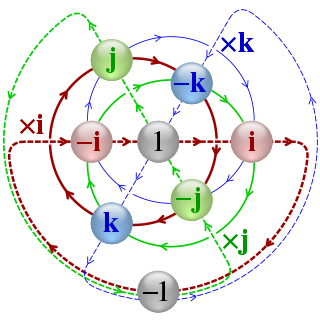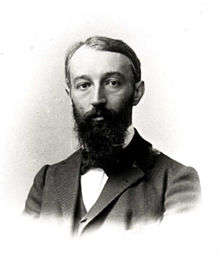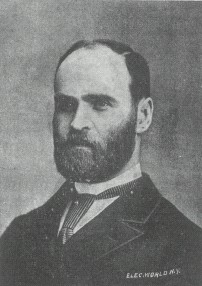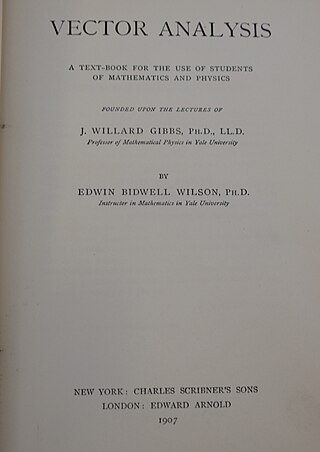In mathematics, a geometric algebra is an extension of elementary algebra to work with geometrical objects such as vectors. Geometric algebra is built out of two fundamental operations, addition and the geometric product. Multiplication of vectors results in higher-dimensional objects called multivectors. Compared to other formalisms for manipulating geometric objects, geometric algebra is noteworthy for supporting vector division and addition of objects of different dimensions.
In mathematics, a Clifford algebra is an algebra generated by a vector space with a quadratic form, and is a unital associative algebra. As K-algebras, they generalize the real numbers, complex numbers, quaternions and several other hypercomplex number systems. The theory of Clifford algebras is intimately connected with the theory of quadratic forms and orthogonal transformations. Clifford algebras have important applications in a variety of fields including geometry, theoretical physics and digital image processing. They are named after the English mathematician William Kingdon Clifford (1845–1879).

In mathematics, the quaternion number system extends the complex numbers. Quaternions were first described by the Irish mathematician William Rowan Hamilton in 1843 and applied to mechanics in three-dimensional space. The algebra of quaternions is often denoted by H, or in blackboard bold by Although multiplication of quaternions is noncommutative, it gives a definition of the quotient of two vectors in a three-dimensional space. Quaternions are generally represented in the form

William Kingdon Clifford was an English mathematician and philosopher. Building on the work of Hermann Grassmann, he introduced what is now termed geometric algebra, a special case of the Clifford algebra named in his honour. The operations of geometric algebra have the effect of mirroring, rotating, translating, and mapping the geometric objects that are being modelled to new positions. Clifford algebras in general and geometric algebra in particular have been of ever increasing importance to mathematical physics, geometry, and computing. Clifford was the first to suggest that gravitation might be a manifestation of an underlying geometry. In his philosophical writings he coined the expression mind-stuff.

Eduard Study, more properly Christian Hugo Eduard Study, was a German mathematician known for work on invariant theory of ternary forms (1889) and for the study of spherical trigonometry. He is also known for contributions to space geometry, hypercomplex numbers, and criticism of early physical chemistry.

Alexander Macfarlane FRSE LLD was a Scottish logician, physicist, and mathematician.
In abstract algebra, the algebra of hyperbolic quaternions is a nonassociative algebra over the real numbers with elements of the form
Alexander McAulay was the first professor of mathematics and physics at the University of Tasmania, Hobart, Tasmania. He was also a proponent of dual quaternions, which he termed "octonions" or "Clifford biquaternions".
Screw theory is the algebraic calculation of pairs of vectors, such as angular and linear velocity, or forces and moments, that arise in the kinematics and dynamics of rigid bodies.
In abstract algebra, the split-quaternions or coquaternions form an algebraic structure introduced by James Cockle in 1849 under the latter name. They form an associative algebra of dimension four over the real numbers.
In mathematics, a versor is a quaternion of norm one. Each versor has the form
In mathematics, a split-biquaternion is a hypercomplex number of the form

In mathematics, the dual quaternions are an 8-dimensional real algebra isomorphic to the tensor product of the quaternions and the dual numbers. Thus, they may be constructed in the same way as the quaternions, except using dual numbers instead of real numbers as coefficients. A dual quaternion can be represented in the form A + εB, where A and B are ordinary quaternions and ε is the dual unit, which satisfies ε2 = 0 and commutes with every element of the algebra. Unlike quaternions, the dual quaternions do not form a division algebra.
A rotor is an object in the geometric algebra of a vector space that represents a rotation about the origin. The term originated with William Kingdon Clifford, in showing that the quaternion algebra is just a special case of Hermann Grassmann's "theory of extension" (Ausdehnungslehre). Hestenes defined a rotor to be any element of a geometric algebra that can be written as the product of an even number of unit vectors and satisfies , where is the "reverse" of —that is, the product of the same vectors, but in reverse order.

Vector Analysis is a textbook by Edwin Bidwell Wilson, first published in 1901 and based on the lectures that Josiah Willard Gibbs had delivered on the subject at Yale University. The book did much to standardize the notation and vocabulary of three-dimensional linear algebra and vector calculus, as used by physicists and mathematicians. It was reprinted by Yale in 1913, 1916, 1922, 1925, 1929, 1931, and 1943. The work is now in the public domain. It was reprinted by Dover Publications in 1960.
William Rowan Hamilton invented quaternions, a mathematical entity in 1843. This article describes Hamilton's original treatment of quaternions, using his notation and terms. Hamilton's treatment is more geometric than the modern approach, which emphasizes quaternions' algebraic properties. Mathematically, quaternions discussed differ from the modern definition only by the terminology which is used.

In mathematics, quaternions are a non-commutative number system that extends the complex numbers. Quaternions and their applications to rotations were first described in print by Olinde Rodrigues in all but name in 1840, but independently discovered by Irish mathematician Sir William Rowan Hamilton in 1843 and applied to mechanics in three-dimensional space. They find uses in both theoretical and applied mathematics, in particular for calculations involving three-dimensional rotations.

A History of Vector Analysis (1967) is a book on the history of vector analysis by Michael J. Crowe, originally published by the University of Notre Dame Press. As a scholarly treatment of a reformation in technical communication, the text is a contribution to the history of science. In 2002, Crowe gave a talk summarizing the book, including an entertaining introduction in which he covered its publication history and related the award of a Jean Scott prize of $4000. Crowe had entered the book in a competition for "a study on the history of complex and hypercomplex numbers" twenty-five years after his book was first published.
The Quaternion Society was a scientific society, self-described as an "International Association for Promoting the Study of Quaternions and Allied Systems of Mathematics". At its peak it consisted of about 60 mathematicians spread throughout the academic world that were experimenting with quaternions and other hypercomplex number systems. The group's guiding light was Alexander Macfarlane who served as its secretary initially, and became president in 1909. The association published a Bibliography in 1904 and a Bulletin from 1900 to 1913.
Aleksandr Petrovich Kotelnikov was a Russian and Soviet mathematician specializing in geometry and kinematics.











